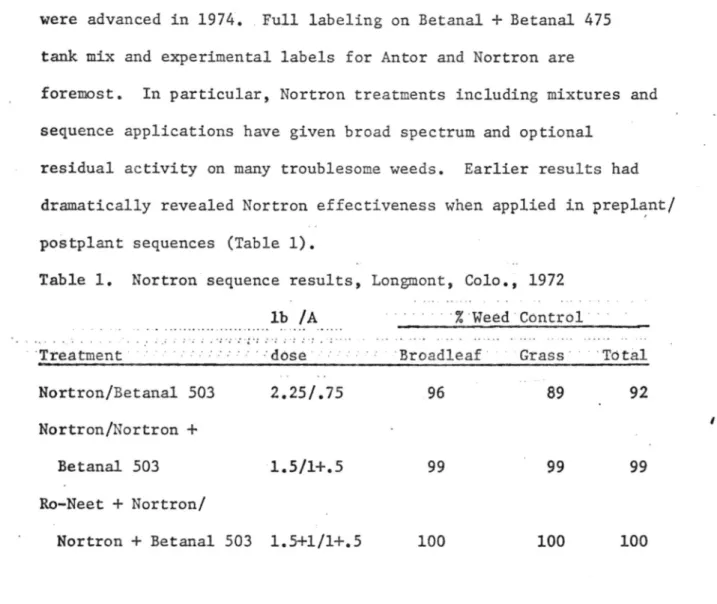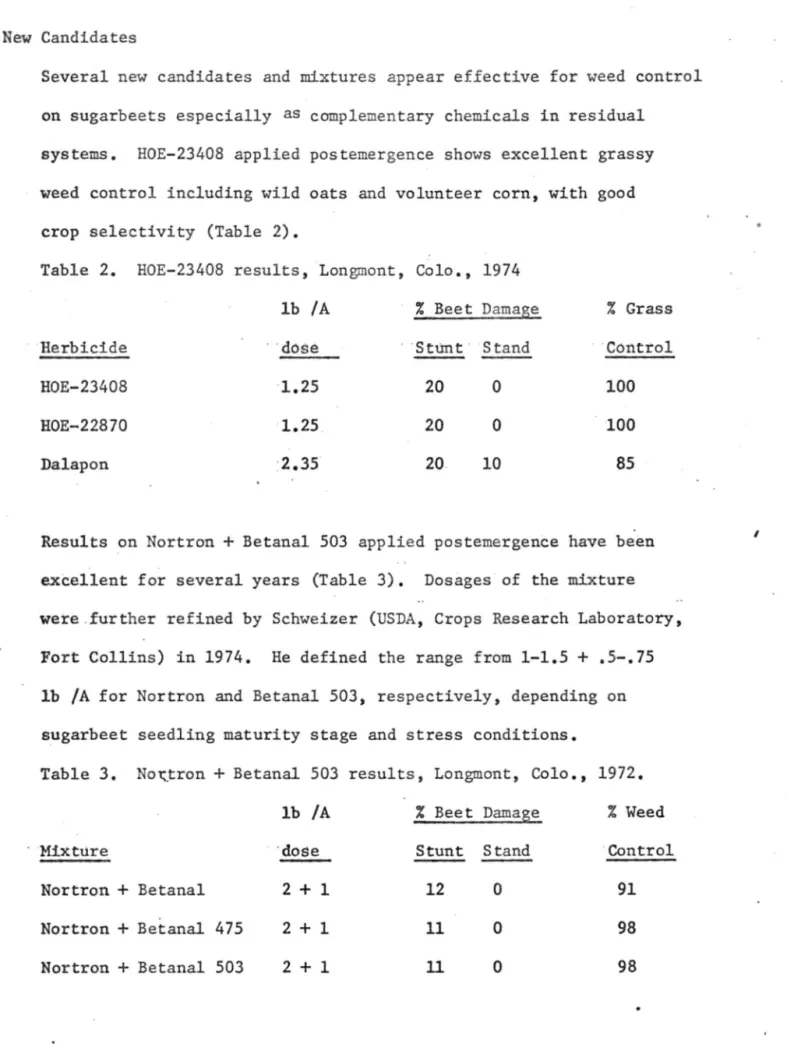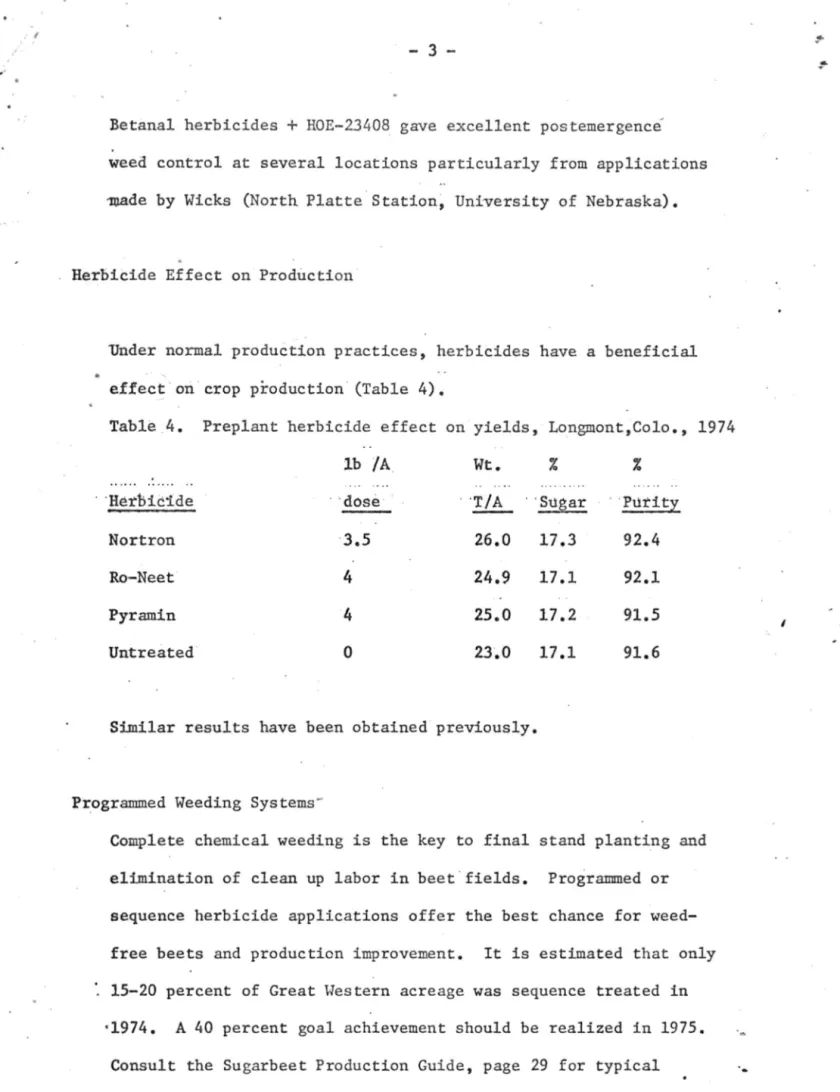Agricultural Research Progress 1974
HERBICIDES Significant Developments
Several important developments in chemical weeding in sugarbeets were advanced in 1974. Full labeling on Betanal
+
Betanal 475tank mix and experimental labels for Antor and Nortron are
foremost. In particular, Nortron treatments including mixtures and sequence applications have given broad spectrum and optional
residual activity on many troublesome weeds. Earlier results had dramatically revealed Nortron effectiveness when applied in prepl~nt/ postplant sequences (Table 1).
Table 1. Nortron sequence results, Longmont, Colo., 1972 lb /A ·· ··· ·· ·%·weed Control .. ;_: : :·: ; . ·:·:·:·;·; :·: .-·: :·: . :····
· ·Treatment· · · _. _. · _. _. _. _. _. · .-dose· ·Broadleaf · Grass· · · · Total
Nortron/Betanal 503 2.25/.75 96 89 92
Nortron/Nortron +
Betanal 503 1.5/1+.5 99 99 99
Ro-Neet + Nortron/
Nortron + Betanal 503 1.s+1/1+.s 100 100 100
These results have been repeated in subsequent years by research at the ARC, USDA and the state stations. · It can be confidently stated that chemical weeding systems have been developed with adequate reliability and persistence to control susceptible weeds from early emergence_until the crop canopy competitively suppresses emerging weeds.
.
.
\ I
• ' ..
"
...
.
~,,
;,,
,._
- 2 -New CandidatesSeveral new candidates and mixtures appear effective for weed control on sugarbeets especially as complementary chemicals in residual
systems. HOE-23408 applied postemergence shows excellent grassy
weed control including wild oats and volunteer corn, with good
crop selectivity (Table 2).
Table 2. HOE-23408 results, Longmont, Colo., 1974
lb /A % Beet Damage % Grass ·Herbicide ·dose · ·stunt· Stand ·control
HOE-23408 ·1.25 20 0 100
HOE-22870 1.25 20 0 100
Dalapon :2.35 20 10 85
Results on Nortron
+
Betanal 503 applied postemergence have been excellent for several years (Table 3). Dosages of the mixturewere.further refined by Schweizer (USDA, Crops Research Laboratory,
Fort Collins) in 1974. He defined the range from 1-1.5
+
.5-.75lb /A for Nortron and Betanal 503, respectively, depending on
sugarbeet seedling maturity stage and stress conditions.
Table 3. No~_tron
+
Betanal 503 results, Longmont, Colo., 1972. lb /A · ·Mi~ture · ·dose Nortron+
Betanal 2+
1 Nortron+
Betanal 475 2+
1 Nortron+
Betanal 503 2+
1 % Beet Damage Stunt Stand 12 0 11 0 11 0 % Weed ·Control 91 98 98 I,I
3
-Betanal herbicides+ HOE-23408 gave excellent postemergence
weed control at several locations particularly from applications
-inade by Wicks (North Platte.Station~ University of Nebraska).
Herbicide Effect on Production
•
1Jnder normal production practices, herbicides have a beneficial
effect.on crop production· (Table 4).
Table
.4.
Preplant herbicide effect on yields, Longmont,Colo., 1974lb /A Wt • % %
... ..
· ·Herbicide . ·dose·. · ·T/A ··Sugar · ·purity
Nortron ·3.5 26.0 17.3 92.4
Ro-Neet 4 24.9 17.1 92.1
Pyramin 4 25.0 17.2 91.5
Untreated 0 23.0 17.1 91.6
Similar results have been obtained previously.
Programmed Weeding Systems
-Complete chemical weeding is the key to final stand planting and
elimination of clean up labor in beet.fields. Programmed or sequence herbicide applications offer the best chance for
weed-free beets and production improvement. It is estimated that only 15-20 percent of Great Western acreage was sequence treated in
·1974. A 40 percent goal achievement should be realized in 1975.
Consult the Sugarbeet Production Guide, page 29 for typical
sequence applications.
, .
..
4
-Nortron Dosages
Preplant Nortron dosages are specific for soil texture (Table 5).
Table 5. Nortron dosages
lb /A Rate of Material, oz./A
Soil.Texture
Sandy loam ....-·
Silt and Clay loam
Clay soil
--·dose 1.1-1.5 1.9-3 3-3.75 · · ·22' Row 30-41 52-81 81-102 7 · inch band 24' · Row 30' Row 27-37 22-30 47-75 38-60 75-93 60-75Apply Antor preplant at the same relative doses as those for Ro-Neet.
Field Recommendations
Herbicide suggestions remain unchanged from those given in detail
in the 1974 Sugarbeet Production Guide. Sequence applications
should be featured in 1975, especially Eptam and Treflan and the
several postemergence herbicides applied after a preplant herbicide.
Betanal tank mix (Betanal
+
Betanal 475) gave excellent results in1974 under large scale-testing. This mixture is broad-spectrum
and applications dosages remain tmchanged. Ro-Neet applied at
2.5-4 lb /A followed by Betanal tank Di.ix at .75-1 lb /A is the most
' advanced sequence available to growers today.
Atrazi-ne Residues
An increase has occurred in Atrazine bioassay tests for agriculturi~~s.
The test requires about 4 weeks for completion. Bioassay tests are
slow compared to chemical tests. Zimdahl (Colorado State University)
is designing a rapid chemical test which will be available in a
\
.
J
.,
/
5
-year or so. Until then, ARC suggests that agriculturists forward
a bioassay sheet with each soil sample of 2 gallons in size.
Research and Future Goals
Chemical weeding programs on sugarbeets commences with crop
emergence and soil stabilization systems aimed at final stand
sowing and seedling vigor enhancement. Growth promoting chemicals
applied to seed may improve crop emergence and early growth rate.
Seedling growth retardation caused by herbicides and puddled
soils may be offset by chemicals applied to young seedlings and
to the soil surface. Competitive crop vigor would be enhanced
early. Selective plant growth regulators that kill or severely
restrict weed growth and prevent seed formation offer promise in
residual-herbistatal weeding systems of the future. Nortron and
MBR-12325 are original chemicals in these systems. Elimination of
unnecessary cultivation and wheel traffic from complete chemical
weeding within and between the rows would greatly augment
sugarbeet production. Thus, integrated elements of future
production designs are: crop emergence and establishment systems
-..
residual weed.and pest control - quality and yield improvement.
Crop protection and growth promoting chemical use is essential to
maximize future production goals.
"· I



